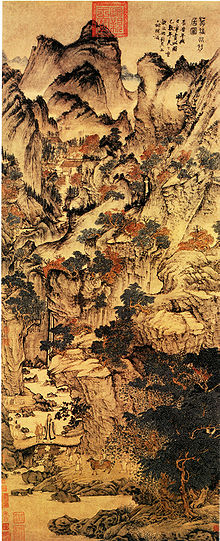This is an old revision of this page, as edited by XLinkBot (talk | contribs) at 05:29, 11 February 2009 (BOT--Reverting link addition(s) by Hongshou to revision 251081785 (http://chinesepaintingcollection.blogspot.com/)). The present address (URL) is a permanent link to this revision, which may differ significantly from the current revision.
Revision as of 05:29, 11 February 2009 by XLinkBot (talk | contribs) (BOT--Reverting link addition(s) by Hongshou to revision 251081785 (http://chinesepaintingcollection.blogspot.com/))(diff) ← Previous revision | Latest revision (diff) | Newer revision → (diff)
Wang Meng (王蒙, Wáng Méng) (c. 1308 – 1385) Chinese painter during the Yuan dynasty. He was born in Huzhou (湖州), now known as Wuxing (吴兴), Zhejiang.
Zi: Shūmíng 叔明
Hao: Xiāngguāng Jūshì 香光居士
Wang Meng is considered to be one of the four great masters of the Yuan Dynasty, along with Huang Gongwang, Wu Zhen, and Ni Zan. They famously refused to serve the Mongolian rulers of their country. Works on silk by them are virtually unknown, an indication of the importance they gave to the calligraphic touch of the brush on paper. They exclusively painted landscapes, which they believed to be the visible key to the invisible reality. They restricted their acquaintenceship to each other, and like-minded "wen ren" (gentleman-scholars).
Wang Meng was the youngest of the group, and the least famous in his own time. Nevertheless, his style greatly influenced later Chinese Painting. In contrast to the relatively spare style of his compatriots, his ropy brushstrokes piled one on the other to produce masses of texture combined in dense and involved patterns.
Many artists copied the works of Wáng Méng centuries after his death, most notably Dong Qichang.
His most famous works are Forest Grotto at Juqu and Dwelling in the Qingbian Mountains.
- Detail from Forest Grotto, Wang Meng Detail from Forest Grotto, Wang Meng
-
 Wang Meng, Forest dwellings in Chü-ch' ü
Wang Meng, Forest dwellings in Chü-ch' ü
Footnotes
- Lee, Pages 460-463
- Lee, Pages 466-467
- Lee, Page 467
- Lee Page 467
References
- Lee, Sherman E. (1994), A History of Far Eastern Art, (5th ed.), Harry N. Abrams Inc., New York, NY